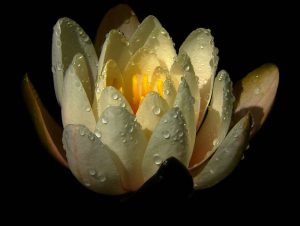Tuesday
Opinion PiecesThe Waiting Game, Part One
Making the most out of the time of your life, by surrendering to opportunities for practice
by William Larsen
 There are some who say “practice makes perfect.” That may be, but after forty years on the meditation cushion, all I can say is that I’m still a long way from having a perfect practice. And maybe that’s the point.
There are some who say “practice makes perfect.” That may be, but after forty years on the meditation cushion, all I can say is that I’m still a long way from having a perfect practice. And maybe that’s the point.
Like householders everywhere, I’ve had to juggle the demands of work, family, and life itself to maintain an ongoing meditation practice. I sit most mornings, but as the day goes on, minutes slip into hours, and the affairs of the day swamp my mind with their incessant call to duty (real and perceived). Too often, I sense my zafu tsk-tsking me as I race through the day, accusing me of (once again) shortchanging my meditation practice. And frankly, that really used to really be a problem.
But no more.
Lately, I’ve made peace with the scolding zafu and its problem with my busy schedule. This has come through the realization that the Dharma affords many gates on the Buddhist path, and I don’t need to bolt myself to the cushion to pursue a meditative life. In fact, throughout every day, options for mindfulness practice abound. These come in many forms, usually dressed as “problems,” and are easy to recognize by the quality of their emotional impact. Jolting me to a stop, they bear the sting of impatience.
At this point, the situation becomes either an obstacle or an opportunity to practice. I call it “the waiting game.”
 One such dilemma presented itself recently, after I had cataract surgery on both eyes. What this meant, beyond the physicality of the surgeries, was……… eye drops! Two medicines—antibiotic and steroid—four times a day. I was told that I should let the drops percolate for two minutes after each eye splash, but could probably cheat a bit without dire consequence. But there would be no cheating for me. Having only one functional eye (due to macular degeneration), I was absolutely committed to achieving the best possible outcome. Two minutes each it would be.
One such dilemma presented itself recently, after I had cataract surgery on both eyes. What this meant, beyond the physicality of the surgeries, was……… eye drops! Two medicines—antibiotic and steroid—four times a day. I was told that I should let the drops percolate for two minutes after each eye splash, but could probably cheat a bit without dire consequence. But there would be no cheating for me. Having only one functional eye (due to macular degeneration), I was absolutely committed to achieving the best possible outcome. Two minutes each it would be.
Healing from the physical effects of the surgery was a snap. The eye drops were a different matter altogether.
 At first I was resentful of the frequent intrusions into my life. After all, four minutes, four times a day, amounts to sixteen minutes of enforced stillness arbitrarily spaced throughout the day. There was just so much to do, and here I was splayed out on the sofa with errant liquid running down my cheeks. Lying there, it just felt so time consuming! And that was the image I was going with as I started the eye drop regimen. Seeing time as a vast, greedy Pac-Man, gobbling the entire space-time continuum as though it were a giant box of Skittles. And me along with it.
At first I was resentful of the frequent intrusions into my life. After all, four minutes, four times a day, amounts to sixteen minutes of enforced stillness arbitrarily spaced throughout the day. There was just so much to do, and here I was splayed out on the sofa with errant liquid running down my cheeks. Lying there, it just felt so time consuming! And that was the image I was going with as I started the eye drop regimen. Seeing time as a vast, greedy Pac-Man, gobbling the entire space-time continuum as though it were a giant box of Skittles. And me along with it.
It was that notion—of time being the devourer of my life—that finally got my attention. The sensation of the drops, wet and runny, was pretty neutral (unlike numbing drops, which sting). It was the waiting that raked my nerves.
 Then I had an insight. For some time I’d craved more meditative space in my life, and now I had it! What was wrong with that? As my old back-to-the-land dharma buddy Joshua used to say: open space to a practitioner is like slop to a hog. So what was going on here?
Then I had an insight. For some time I’d craved more meditative space in my life, and now I had it! What was wrong with that? As my old back-to-the-land dharma buddy Joshua used to say: open space to a practitioner is like slop to a hog. So what was going on here?
Eventually, the questioning came down to this: if I truly did desire a more contemplative life, why resist these brief interludes the eye drops were offering?
Since I’m a questioning sort (as in, “What the hell am I going to do with this time?”), it didn’t take long to gather my resources and start figuring things out. The years of meditation practice kicked in, and I started to realize that all I had to do was………nothing.
 The situation simply needed re-framing: I wasn’t a captive imprisoned within an inescapable predicament. I was on a mini-retreat! How cool was that, especially since it was a freebie and sitting with impatience was the only cost. What more could a practitioner want?
The situation simply needed re-framing: I wasn’t a captive imprisoned within an inescapable predicament. I was on a mini-retreat! How cool was that, especially since it was a freebie and sitting with impatience was the only cost. What more could a practitioner want?
True to form, once I got it I dove in, anticipating the “drop times” (as I called them)with eager intention. And my experience of those pesky interruptions began to shift. From being mosquito-like irritants, they started to become welcome focal points in my schedule. Counting the up-and-down time, I saw the “intrusions” as five-minute mindfulness breaks, peaceful respites from the daily pressures. In effect, the splash of fluid on my eye became a mindfulness bell, calling me back to myself as I reclined on the sofa. Sixteen times a day. It wasn’t exactly a kick-ass monk-killer retreat, but, when done with conscious intent, enough to snag the attention. It sure got mine.
 William Larsen is a longtime practitioner and psychotherapist who lives with his wife in Nevada City, California. He has been a practicing psychotherapist for over forty-five years, and has specialized in utilizing a mindfulness-based approach to the treatment of trauma.
William Larsen is a longtime practitioner and psychotherapist who lives with his wife in Nevada City, California. He has been a practicing psychotherapist for over forty-five years, and has specialized in utilizing a mindfulness-based approach to the treatment of trauma.
















